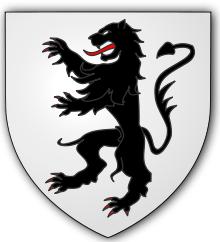Jones of Faerdref Uchaf

The Jones of Faerdref Uchaf family is a Welsh gentry family from the parish of Llandrillo-yn-Edeirnion, Merionethshire. They are a cadet branch of the Hughes of Gwerclas family, descending from the younger brother of the 7th Baron of Kymmer-yn-Edeirnion, Gruffydd ap Rhys ab Ieuan (d. 1489), 'Baron of Crogen and Branas', who was famed for his pilgrimage to Santiago di Compostella. He was a Lancastrian and later supported his kinsman Henry Tudor. He was a patron of the bards, most notably Lewys Glyn Cothi.[1]
The eponymous ancestor of the family was John ap Rhydderch ap John ap Hywel ap Gruffydd ap Rhys, of Faerdref Uchaf, who appears in the visitations of Wales in 1594.[1][2] His son, Maurice Jones of Faerdref Uchaf, Esq. (1597- ca. 1655), was the first to adopt the surname 'Jones'.[3] Faerdref Uchaf house no longer exists but would have been a very similar house to the surviving Branas Uchaf and Plas Uchaf. Ty Uchaf was built on its site in the 1680s.
The family, like their kinsmen, were Royalists during the English Civil War, and two of Maurice's sons, Capt. John Jones and Lt. Nathanael Jones, fought at the Battle of Marston Moor, leading a company of men from Llandrillo.[4] Later, Nathanael achieved minor fame as a native Welsh poet and translator of theological textbooks, such as works by Jeremy Taylor from English into Welsh, so that they could be more widely read.[5][6] He also served as a Justice of the Peace and coroner for Merionethshire, and became High Sheriff of Merionethshire in 1673.[7] His son, Maurice, also served as High Sheriff in 1684.
By the mid-19th century, following the Industrial revolution, the family had largely lost their ancestral lands and had dispersed into the neighbouring counties of Shropshire and Cheshire. An elaborate 18th century memorial tablet to the family remains in the parish church of Llandrillo.
As descendants of Owain Brogyntyn, they bear the 'Black Lion' of Powys on their escutcheon and keep the motto 'Kymmer-yn-Edeirnion', in memory of their ancestral seat.[1]
References
- 1 2 3 Meyrick, S.R. (1846). Heraldic visitations of Wales and part of the Marches: between the years 1586 and 1613, under the authority of Clarencieux and Norroy, two kings at arms, volume 2. p. 126.
- ↑ Owen, B (1954). "A Merioneth Subsidy Roll 42 Elizabeth I 1599/1600". Journal of the Merioneth Historical and Record Society. 2: 151–3, 240.
- ↑ Jenkins, J (1889). "Llyfr Silin yn cynwys achau amryw deuluoedd yn Ngwynydd, Powys". Archaeologia Cambrensis. 6: 162.
- ↑ Tucker, N (1961). Royalist Officers of North Wales: 1642-1660. pp. 35, 40.
- ↑ Jones, E.D. (1952). "The Brogyntyn Welsh Manuscripts: XII". Cylchgrawn Llyfregll Genedlaethol Cymru. 7: 279–80.
- ↑ Blome, Richard (1892). An Alphabetical account of the Nobility and Gentry, which are (or lately were) related unto the several counties of England and Wales in 1673 (Reprint). p. 119.
- ↑ Roberts, P.R. (1965). "THE MERIONETH GENTRY AND LOCAL GOVERNMENT circa 1650-1838". Cylchgrawn Cymdeithas Hanes a Chofnodion Sir Feirionydd. 5: 27.